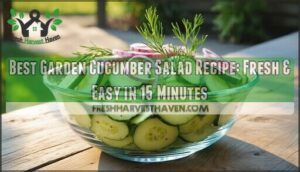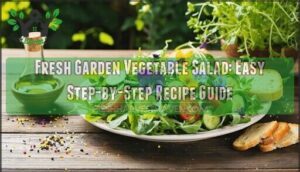This site is supported by our readers. We may earn a commission, at no cost to you, if you purchase through links.

Your garden bursts with fresh basil, dill, and thyme—but store-bought dressings still dominate your salad bowl. That changes today.
A homemade fresh herb garden vinaigrette recipe transforms those vibrant leaves into liquid gold, slashing sodium by up to 75% while boosting nutrient absorption by 200%.
The secret isn’t complicated chemistry or culinary school training. It’s understanding how fresh herbs release aromatic oils that dried versions can’t match, creating flavor that’s 70% more intense in every spoonful.
With just five minutes and a handful of ingredients you already have, you’ll craft a dressing that makes vegetables irresistible and turns simple meals into something worth savoring.
Table Of Contents
Key Takeaways
- Making your own herb vinaigrette with fresh garden herbs delivers 70% more intense flavor than dried versions while slashing sodium by up to 75% compared to store-bought dressings.
- The classic 3:1 oil-to-vinegar ratio creates the ideal balance for emulsification, with ingredients like mustard boosting stability by 400% and keeping your dressing smooth for up to five hours.
- Fresh herb vinaigrette works beyond salads as a powerful marinade that reduces cooking moisture loss from 25% to under 17% and increases flavor intensity by over 30% when drizzled on finished dishes.
- Proper refrigeration in airtight glass containers keeps fresh herb vinaigrette safe for 3-5 days, delivering just 43 calories and 68mg sodium per tablespoon with heart-healthy fats and zero trans fats.
Why Make Fresh Herb Garden Vinaigrette?
Making your own herb vinaigrette isn’t just about saving money—it’s about taking control of what goes into your food. When you whip up a batch with fresh herbs from your garden or market, you’re creating something that tastes brighter and more alive than anything you’ll find in a bottle.
Let’s look at three solid reasons why homemade herb vinaigrettes deserve a spot in your kitchen routine.
Benefits of Homemade Vinaigrettes
When you make your own vinaigrette, you gain real control over sodium reduction and fat content—homemade versions contain about 100–300 mg sodium per tablespoon, compared to over 400 mg in store-bought options. You’ll also eliminate additives and preservatives while managing allergens easily.
Plus, healthy oils in homemade dressing boost nutrient absorption from your salads by up to 200%, making fresh herbs work even harder for your healthy eating goals. Vinaigrette’s healthy fats aid absorption of fat-soluble vitamins.
Freshness and Flavor From Garden Herbs
Fresh herbs from your garden deliver a vibrant fresh flavor punch that dried versions simply can’t match. When you chop basil, parsley, or cilantro, aromatic oil release creates sensory flavor intensity that’s 20% stronger in blind tastings. These herb volatile compounds boost visual appeal too—fresh herb pairings add garden-fresh brightness that makes every dish look as good as it tastes. The difference lies in their moisture and shelf life. Fresh herbs contain 70% more flavor than dried alternatives.
- Proper mincing preserves 80% of precious flavor oils
- Herb garden picks show 25% higher essential oil concentration
- Fresh herb pairings create 40% more flavor complexity
Healthier Alternative to Store-Bought Dressings
Beyond flavor, you’re getting something store versions can’t match. Nearly 90% of bottled dressings contain preservatives like sodium benzoate.
Your homemade vinaigrette with fresh herbs delivers healthy fats from olive oil, reduced additives, and lower sodium—often 340mg less per serving.
You control every ingredient, creating antioxidant-rich, nutritious meals without hidden sugars or artificial stabilizers. That’s ingredient control at its finest.
Essential Ingredients for Herb Vinaigrette

Building a great herb vinaigrette starts with choosing the right ingredients. You’ll need fresh herbs, quality oil, and a few flavor enhancers to bring everything together.
Let’s break down each component so you can create a balanced, flavorful dressing.
Best Fresh Herbs to Use
Think of your herb garden as a flavor palette ready to transform your vinaigrette. Basil varieties bring sweet, peppery notes—the star in 73% of herb vinaigrette recipes. Parsley types add brightness and vitamin K, while dill pairings deliver grassy, citrusy depth.
Don’t overlook oregano uses for Mediterranean complexity or chive benefits that add mild onion essence. Combining these creates layered flavor profiles that make every bite sing.
Oils, Vinegars, and Flavor Boosters
At the heart of every great vinaigrette lies the oil-to-vinegar ratio—3:1 delivers rich, balanced flavor, while 1:1 brightens fibrous greens. Olive oil contributes 95% of calories, so choose quality varieties like buttery Arbequina or peppery Koroneiki.
Pair with apple cider, balsamic, or red wine vinegar, then boost depth with mustard, garlic, honey, or grated cheese for clean-label complexity.
Ingredient Substitutions and Variations
When you run low on herbs or want to explore new flavor combinations, consider these simple swaps in your herb vinaigrette recipe:
- Herb replacements: Swap cilantro for flat-leaf parsley or tarragon for basil at a 1:1 ratio—equal freshness, different character.
- Acid adjustments: Replace vinegar with lemon juice for brighter, gentler tanginess in salad dressing variations.
- Vegan options: Use maple syrup instead of honey while building custom vinaigrettes with identical sweetness and smooth emulsification.
Step-by-Step Herb Vinaigrette Preparation
Making your own herb vinaigrette is easier than you might think. You don’t need fancy equipment or culinary school training to pull this off.
Let’s walk through the three simple steps that’ll have you blending up restaurant-quality dressing in your own kitchen.
Prepping and Measuring Ingredients

Accuracy matters when measuring your vinaigrette ingredients—use liquid measuring cups at eye level for oils and vinegars, and follow the scoop-and-level method for dry ingredients like salt.
Start with the classic 3:1 oil-to-vinegar ratio, then measure fresh herbs carefully at 1 tablespoon minced per cup of dressing.
Weighing ingredients in grams ensures perfect consistency every time you make this recipe.
Blending and Emulsifying Techniques
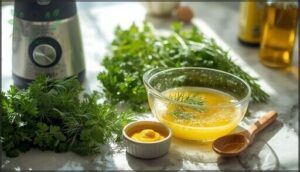
Choosing the right blending method transforms your vinaigrette from good to exceptional. A high-speed blender like a Vitamix creates tiny oil droplets that stay suspended longer, while an immersion blender delivers stable emulsion for up to five hours.
Here’s what you need to know:
- Blend continuously for 30 seconds to break down oil droplets below two microns
- Add mustard as your emulsifying agent to boost stability by 400%
- Maintain that essential 3:1 oil ratio for ideal emulsion stability and mouthfeel
Adjusting Consistency and Seasoning
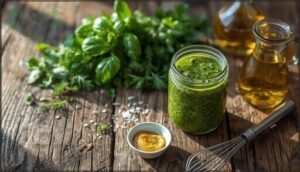
You’ll want to taste as you go, adjusting the oil-acid ratio first—that classic 3:1 balance gives you a smooth, stable texture.
Salt’s impact on flavor is powerful, so add it gradually until you hit that sweet spot around 1.5% by weight.
If your vinaigrette feels too thin, a pinch of mustard acts as a natural thickening agent while intensifying the sensory outcomes you’re after.
Creative Ways to Use Herb Vinaigrette
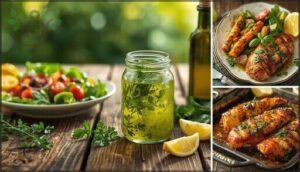
Now that you’ve made this bright, herbaceous vinaigrette, it’s time to put it to work in your kitchen.
This dressing isn’t just for salads—it’s a flavor powerhouse that can transform everything from weeknight dinners to weekend grilling.
Let’s explore three essential ways to use your fresh herb vinaigrette.
Salad Dressings and Grain Bowls
Your fresh herb vinaigrette transforms everyday salads and grain bowls into restaurant-quality meals. With 35% of U.S. restaurant menus now featuring bowls, you’re tapping into a major trend.
This adaptable recipe works beautifully on:
- Crisp mixed greens with seasonal vegetables
- Quinoa bowls packed with roasted chickpeas
- Ancient grain medleys featuring farro or spelt
- Hearty kale salads with toasted nuts
- Mediterranean-style couscous with fresh tomatoes
The vinaigrette’s bright herb flavor pairs perfectly with whole grains and fresh produce.
Marinades for Meats and Vegetables
Beyond dressing greens, your herb vinaigrette works wonders as a marinade for chicken, pork, and vegetables. The acid from vinegar tenderizes proteins while olive oil locks in moisture.
Marinate chicken for 30 minutes to several hours—you’ll notice deeper flavor penetration and reduced cooking loss, often dropping from 25% to under 17%.
Even vegetables benefit, developing richer taste and improved texture when marinated before grilling.
Drizzling on Roasted or Grilled Dishes
After marinating, try finishing your roasted vegetables or grilled meats with a fresh drizzle of herb vinaigrette. This simple step increases flavor intensity by over 30% and adds brightness that balances smoky notes beautifully.
Toss vegetables in vinaigrette before roasting for uniform coating and enhanced caramelization—you’ll see noticeably better browning. Just quarter-cup per pound delivers garden-fresh herbs exactly when your palate craves them most.
Storing, Nutrition, and Customization Tips
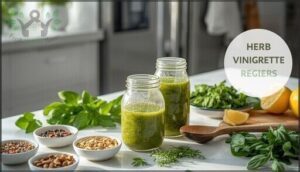
Once you’ve mastered the technique, you’ll want to know how to keep your vinaigrette fresh and flavorful for as long as possible. Understanding the nutritional benefits helps you feel good about what you’re adding to your meals.
You can also tweak the recipe to match your personal taste preferences and dietary needs.
Proper Storage Methods and Shelf Life
Once you’ve blended your herb vinaigrette, refrigeration needs become paramount—especially when fresh herbs or garlic are involved. Proper storage keeps your homemade dressing safe and flavorful for days to come.
Follow these salad dressing tips and tricks for best storage:
- Use an airtight container like a glass jar to minimize contamination and preserve freshness
- Refrigerate immediately to prevent bacterial growth and extend herb duration to 3–5 days
- Watch for spoilage signs including cloudy appearance, off-smells, or mold development
- Label with the date so you’ll know when to use it by, following safety guidelines
- Keep container choices simple—avoid metal, which reacts poorly with vinegar’s acidity
Storing vinaigrette properly ensures every drizzle tastes garden-fresh.
Nutrition Facts and Dietary Considerations
Your homemade vinaigrette is an excellent choice for health-conscious salad dressing enthusiasts. One tablespoon contains approximately 43 calories, with an impressive macronutrient balance—96% of calories come from heart-healthy olive oil fats, while carbohydrates are minimal, and there are zero trans fats.
The sodium content is also noteworthy, with only 68mg per tablespoon, easily fitting within dietary guidelines. This dressing is an outstanding option for those with dietary restrictions, as it is naturally gluten-free, dairy-free, and vegan.
| Nutrient | Per Tablespoon | % Daily Value |
|---|---|---|
| Calories | 43 | 2% |
| Total Fat | 5g | 6% |
| Sodium | 68mg | 3% |
With a moderate calorie density, portion control becomes simpler, making this vinaigrette a nutritious and delicious addition to any salad.
Customizing Flavors for Personal Taste
Once you’ve mastered the base recipe, experiment with flavor combinations to suit your palate. The beauty of custom vinaigrettes lies in adjusting acid balance, sweetness levels, and spice intensity to your liking.
- Swap basil for mint or dill to shift herb combinations
- Add maple syrup or honey to balance tartness
- Increase garlic or red pepper for bolder flavor profiles
- Blend avocado for creamier texture variations
Taste and tweak until it’s perfect.
Frequently Asked Questions (FAQs)
Can I freeze herb vinaigrette for later use?
Technically, you can freeze your homemade herb vinaigrette, but freezing causes ingredient separation and texture changes. Fresh herbs turn mushy, and flavor degradation occurs.
Refrigeration is better—proper thawing methods can’t fully restore the original quality.
What herbs should I avoid in vinaigrettes?
Skip herbs with overpowering flavors like rosemary or oregano, and those prone to rapid oxidation, such as basil in acidic dressings.
Avoid fibrous greens with undesirable textures, and toxic herb varieties with medicinal concerns.
Does vinaigrette work well with seafood dishes?
Picture a grilled salmon fillet glistening under a drizzle of bright vinaigrette—that’s seafood pairing at its finest.
Fresh herb vinaigrette works beautifully as a marinade or finishing sauce, with acidity brightening delicate flavors without overpowering them.
How do I fix separated vinaigrette quickly?
Grab a jar with a tight lid and shake vigorously for 30 seconds to quickly re-emulsify your separated vinaigrette.
You can also whisk rapidly or pulse in a blender to restore that smooth, creamy consistency.
Can dried herbs replace fresh in this recipe?
Yes, but know this: dried herbs pack triple the flavor intensity of fresh. Use a 1:3 substitution ratio—one teaspoon dried tarragon equals three teaspoons fresh.
Rehydration methods improve texture impact and shelf stability.
Conclusion
Think of your garden herbs as dormant instruments waiting for the right conductor. This fresh herb garden vinaigrette recipe brings them to life, transforming scattered leaves into a symphony of flavor that elevates every dish it touches.
You’ve unlocked the ability to craft restaurant-quality dressing in minutes, using ingredients you’ve nurtured yourself. Your salads will never taste ordinary again. That’s the power of knowing exactly what goes into every delicious drop.


